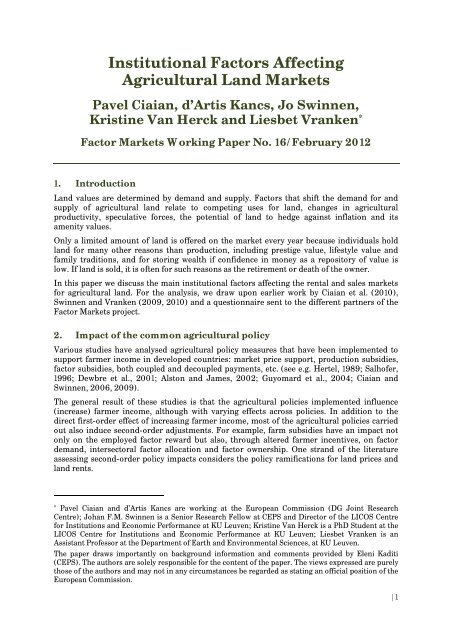Institutional Factors Affecting Agricultural Land Markets
Institutional Factors Affecting Agricultural Land Markets
Institutional Factors Affecting Agricultural Land Markets
Create successful ePaper yourself
Turn your PDF publications into a flip-book with our unique Google optimized e-Paper software.
<strong>Institutional</strong> <strong>Factors</strong> <strong>Affecting</strong><br />
<strong>Agricultural</strong> <strong>Land</strong> <strong>Markets</strong><br />
Pavel Ciaian, d’Artis Kancs, Jo Swinnen,<br />
Kristine Van Herck and Liesbet Vranken *<br />
Factor <strong>Markets</strong> Working Paper No. 16/February 2012<br />
1. Introduction<br />
<strong>Land</strong> values are determined by demand and supply. <strong>Factors</strong> that shift the demand for and<br />
supply of agricultural land relate to competing uses for land, changes in agricultural<br />
productivity, speculative forces, the potential of land to hedge against inflation and its<br />
amenity values.<br />
Only a limited amount of land is offered on the market every year because individuals hold<br />
land for many other reasons than production, including prestige value, lifestyle value and<br />
family traditions, and for storing wealth if confidence in money as a repository of value is<br />
low. If land is sold, it is often for such reasons as the retirement or death of the owner.<br />
In this paper we discuss the main institutional factors affecting the rental and sales markets<br />
for agricultural land. For the analysis, we draw upon earlier work by Ciaian et al. (2010),<br />
Swinnen and Vranken (2009, 2010) and a questionnaire sent to the different partners of the<br />
Factor <strong>Markets</strong> project.<br />
2. Impact of the common agricultural policy<br />
Various studies have analysed agricultural policy measures that have been implemented to<br />
support farmer income in developed countries: market price support, production subsidies,<br />
factor subsidies, both coupled and decoupled payments, etc. (see e.g. Hertel, 1989; Salhofer,<br />
1996; Dewbre et al., 2001; Alston and James, 2002; Guyomard et al., 2004; Ciaian and<br />
Swinnen, 2006, 2009).<br />
The general result of these studies is that the agricultural policies implemented influence<br />
(increase) farmer income, although with varying effects across policies. In addition to the<br />
direct first-order effect of increasing farmer income, most of the agricultural policies carried<br />
out also induce second-order adjustments. For example, farm subsidies have an impact not<br />
only on the employed factor reward but also, through altered farmer incentives, on factor<br />
demand, intersectoral factor allocation and factor ownership. One strand of the literature<br />
assessing second-order policy impacts considers the policy ramifications for land prices and<br />
land rents.<br />
* Pavel Ciaian and d’Artis Kancs are working at the European Commission (DG Joint Research<br />
Centre); Johan F.M. Swinnen is a Senior Research Fellow at CEPS and Director of the LICOS Centre<br />
for Institutions and Economic Performance at KU Leuven; Kristine Van Herck is a PhD Student at the<br />
LICOS Centre for Institutions and Economic Performance at KU Leuven; Liesbet Vranken is an<br />
Assistant Professor at the Department of Earth and Environmental Sciences, at KU Leuven.<br />
The paper draws importantly on background information and comments provided by Eleni Kaditi<br />
(CEPS). The authors are solely responsible for the content of the paper. The views expressed are purely<br />
those of the authors and may not in any circumstances be regarded as stating an official position of the<br />
European Commission.<br />
| 1








